Dual Band Electrically Small Complementary Double Negative Structure Loaded Metamaterial Inspired Circular Microstrip Patch Antenna for WLAN Applications
Abstract
:1. Introduction
2. Circular Patch Antenna Design
3. Design and Characterisation of CDNG-MTM
4. Antenna Geometry and Design
5. Parametric Analysis
6. Experimental Validation
7. Conclusions
Author Contributions
Funding
Data Availability Statement
Conflicts of Interest
References
- Wheeler, H.A. Fundamental Limitations of Small Antennas. Proc. IRE 1947, 35, 1479–1484. [Google Scholar] [CrossRef]
- Sonak, R.; Ameen, M.; Chaudhary, R.K. CPW-fed electrically small open-ended zeroth order resonating metamaterial antenna with dual-band features for GPS/WiMAX/WLAN applications. AEU Int. J. Electron. Commun. 2019, 104, 99–107. [Google Scholar] [CrossRef]
- Sohrabi, A.; Dashti, H.; Ahmadi-Shokouh, J. Design and analysis of a broadband electrically small antenna using characteristic mode theory. AEU Int. J. Electron. Commun. 2020, 113, 152991. [Google Scholar] [CrossRef]
- Sum, Y.L.; Rheinheimer, V.; Soong, B.H.; Monteiro, P.J. Scalable 2.45 GHz electrically small antenna design for metaresonator array. J. Eng. 2017, 5, 170–174. [Google Scholar] [CrossRef]
- Patel, R.; Desai, A.; Upadhyaya, T.K. An Electrically Small Antenna Using Defected Ground Structure for RFID, GPS and IEEE 802.11 A/B/G/S Applications. Prog. Electromagn. Res. Lett. 2018, 75, 75–81. [Google Scholar] [CrossRef] [Green Version]
- Kucukoner, E.M.; Cinar, A.; Kose, U.; Ekmekci, E. Electrical Size Reduction of Microstrip Antennas by Using Defected Ground Structures Composed of Complementary Split Ring Resonator. Adv. Electromagn. 2021, 10, 62–69. [Google Scholar] [CrossRef]
- Mahmud, M.Z.; Islam, M.T.; Misran, N.; Singh, M.J.; Mat, K. A Negative Index Metamaterial to Enhance the Performance of Miniaturized UWB Antenna for Microwave Imaging Applications. Appl. Sci. 2017, 7, 1149. [Google Scholar] [CrossRef] [Green Version]
- Rajni, R.; Marwaha, A. Electrically Small Microstrip Patch Antenna Loaded with Spiral Resonator for Wireless Applications. Wirel. Pers. Commun. 2017, 96, 2621–2632. [Google Scholar] [CrossRef]
- Smith, D.R.; Padilla, W.J.; Vier, D.C.; Nemat-Nasser, S.C.; Schultz, S. Composite medium with simultaneously negative permeability and permittivity. Phys. Rev. Lett. 2000, 84, 4184–4187. [Google Scholar] [CrossRef] [Green Version]
- Kumar, P.; Ali, T.; Pai, M.M.M. Electromagnetic Metamaterials: A New Paradigm of Antenna Design. IEEE Access 2021, 9, 18722–18751. [Google Scholar] [CrossRef]
- Ameen, M.; Chaudhary, R.K. Metamaterial CP antenna: A new technique for bandwidth-enhanced circularly polarized ZOR antenna based on ENG-TL backed coupled SSR with AMC metasurface. IEEE Antennas Propag. Mag. 2019. [Google Scholar] [CrossRef]
- Caloz, C.; Itoh, T. Electromagnetic Metamaterials: Transmission Line Approach and Microwave Applications; Wiley: Hoboken, NJ, USA, 2005. [Google Scholar]
- Ameen, M.; Chaudhary, R.K. Metamaterial-based circularly polarised antenna employing ENG-TL with enhanced bandwidth for WLAN applications. Electron. Lett. 2018, 54, 1152–1154. [Google Scholar] [CrossRef]
- Ziolkowski, R.W. Design, fabrication, and testing of double negative metamaterials. IEEE Trans. Antennas Propag. 2003, 51, 1516–1529. [Google Scholar] [CrossRef]
- Erentok, A.; Ziolkowski, R.W. Metamaterial-inspired efficient electrically small antennas. IEEE Trans. Antennas Propag. 2008, 57, 691–707. [Google Scholar] [CrossRef] [Green Version]
- Ziolkowski, R.W.; Jin, P.; Lin, C.C. Metamaterial-inspired engineering of antennas. IEEE. Proc. 2011, 99, 1720–1731. [Google Scholar] [CrossRef]
- Ameen, M.; Chaudharym, R.K. Dual-layer and dual-polarized metamaterial inspired antenna using circular-complementary split ring resonator mushroom and metasurface for wireless applications. AEU Int. J. Electron. Commun. 2020, 113, 152977. [Google Scholar] [CrossRef]
- Raval, F.; Kosta, Y.P.; Joshi, H. Reduced size patch antenna using complementary split ring resonator as defected ground plane. Int. J. Electron. Commun. 2015, 69, 1126–1133. [Google Scholar] [CrossRef]
- Rajeshkumar, V.; Raghavan, S. A compact CSRR loaded dual band microstrip patch antenna for wireless applications. In Proceedings of the 2013 IEEE International Conference on Computational Intelligence and Computing Research, Enathi, India, 26–28 December 2013. [Google Scholar]
- Fritz-Andrade, E.; Tirado-Mendez, J.A.; Jardon-Aguilar, H.; Flores-Leal, R. Application of complementary split ring resonators for size reduction in patch antenna arrays. J. Electromagn. Waves Appl. 2017, 31, 1755–1768. [Google Scholar] [CrossRef]
- Rashid, M.; Munir, M.E.; Khan, J.; Mahmood, K. Design of miniaturized multiband microstrip patch antenna using defected ground structure. Int. J. Adv. Comput. Sci. Appl. 2018, 9, 168–173. [Google Scholar] [CrossRef]
- Reddaf, A.; Djerfaf, F.; Ferroudji, K. Design of dual-band antenna using an optimized complementary split ring resonator. Appl. Phys. A 2019, 125, 186. [Google Scholar] [CrossRef]
- Yeo, J.; Lee, J. Design of a high-sensitivity microstrip patch sensor antenna loaded with a defected ground structure based on a complementary split ring resonator. Sensors 2020, 20, 7064. [Google Scholar] [CrossRef] [PubMed]
- Rajni, R.; Marwaha, A. CSC-SR structure loaded electrically small planar antenna. Appl. Comput. Electromagn. Soc. J. 2016, 31, 591–598. [Google Scholar]
- Abdalla, M.A.; Wahba, W.W.; Allam, A.A. Analysis and design of a compact CRLH inspired—Defected ground resonators for triple band antenna applications. Eng. Sci. Technol. Int. J. 2020, 23, 114–122. [Google Scholar] [CrossRef]
- Joshi, J.G.; Pattnaik, S.S.; Devi, S.; Lohokare, M.R. Electrically Small Patch Antenna Loaded with Metamaterial. IETE J. Res. 2010, 56, 373–379. [Google Scholar] [CrossRef]
- Karimbu Vallappil, A.; Khawaja, B.A.; Rahim, M.K.A.; Iqbal, M.N.; Chattha, H.T. Metamaterial-Inspired Electrically Compact Triangular Antennas Loaded with CSRR and 3 × 3 Cross-Slots for 5G Indoor Distributed Antenna Systems. Micromachines 2022, 13, 198. [Google Scholar] [CrossRef]
- Hasan, M.M.; Rahman, M.; Faruque, M.R.I.; Islam, M.T.; Khandaker, M.U. Electrically Compact SRR-Loaded Metamaterial Inspired Quad Band Antenna for Bluetooth/WiFi/WLAN/WiMAX System. Electronics 2019, 8, 790. [Google Scholar] [CrossRef] [Green Version]
- Balanis, C.A. Antenna Theory: Analysis and Design; John Wiley & Sons: New York, NY, USA, 1989. [Google Scholar]
- Thankachan, S.; Paul, B.; Pradeep, A.; Moolat, R. Design and Characterisation of Simple Planar Metamaterial Structure with Double Negative Properties. In Proceedings of the TENCON 2019— 2019 IEEE Region 10 Conference (TENCON), Kochi, India, 17–20 October 2019; pp. 1231–1235. [Google Scholar]
- Ekmekci, E.; Turhan-Sayan, G. Comparative Investigation of Resonance Characteristics And Electrical Size Of The Double-Sided Srr, Bc-Srr And Conventional Srr Type Metamaterials For Varying Substrate Parameters. Prog. Electromagn. Res. B 2009, 12, 35–62. [Google Scholar] [CrossRef] [Green Version]
- Marqus, R.; Martn, F.; Sorolla, M. Metamaterials with Negative Parameters; John Wiley & Sons, Inc.: Hoboken, NJ, USA, 2008. [Google Scholar]
- Li, Z.; Aydin, K.; Ozbay, E. Determination of the effective constitutive parameters of bianisotropic metamaterials from reflection and transmission coefficients. Phys. Rev. E Stat. Phys. Plasmas Fluids Relat. Interdiscip. Top. 2009, 79, 026610. [Google Scholar] [CrossRef]
- Zsolt, S.; Park, G.H.; Ravi, H.; Li, E.-P. A unique extraction of metamaterial parameters based on Kramers–Kronig relationship. IEEE Trans. Microw. Theory Tech. 2010, 58, 2646–2653. [Google Scholar]
- Smith, D.R.; Vier, D.C.; Koschny, T.; Soukoulis, C.M. Electromagnetic parameter retrieval from inhomogeneous metamaterials. Phys. Rev. E 2005, 71, 036617. [Google Scholar] [CrossRef] [Green Version]
- Numan, A.B.; Sharawi, M.S. Extraction of Material Parameters for Metamaterials Using a Full-Wave Simulator [Education Column]. IEEE Antennas Propag. Mag. 2013, 55, 202–211. [Google Scholar] [CrossRef]
- Chen, X.; Grzegorcezyk, T.M.; Wu, B.; Pacheco, J., Jr.; Kong, J.A. Robust Method to Retrieve the Constitutive Effective Parameters of Metamaterials. Phys. Rev. E 2004, 70, 016608. [Google Scholar] [CrossRef] [PubMed] [Green Version]
- ANSYS High Frequency Structure Simulator (HFSS); Version 15; Ansys Corporation: Pittsburgh, PA, USA, 2015.
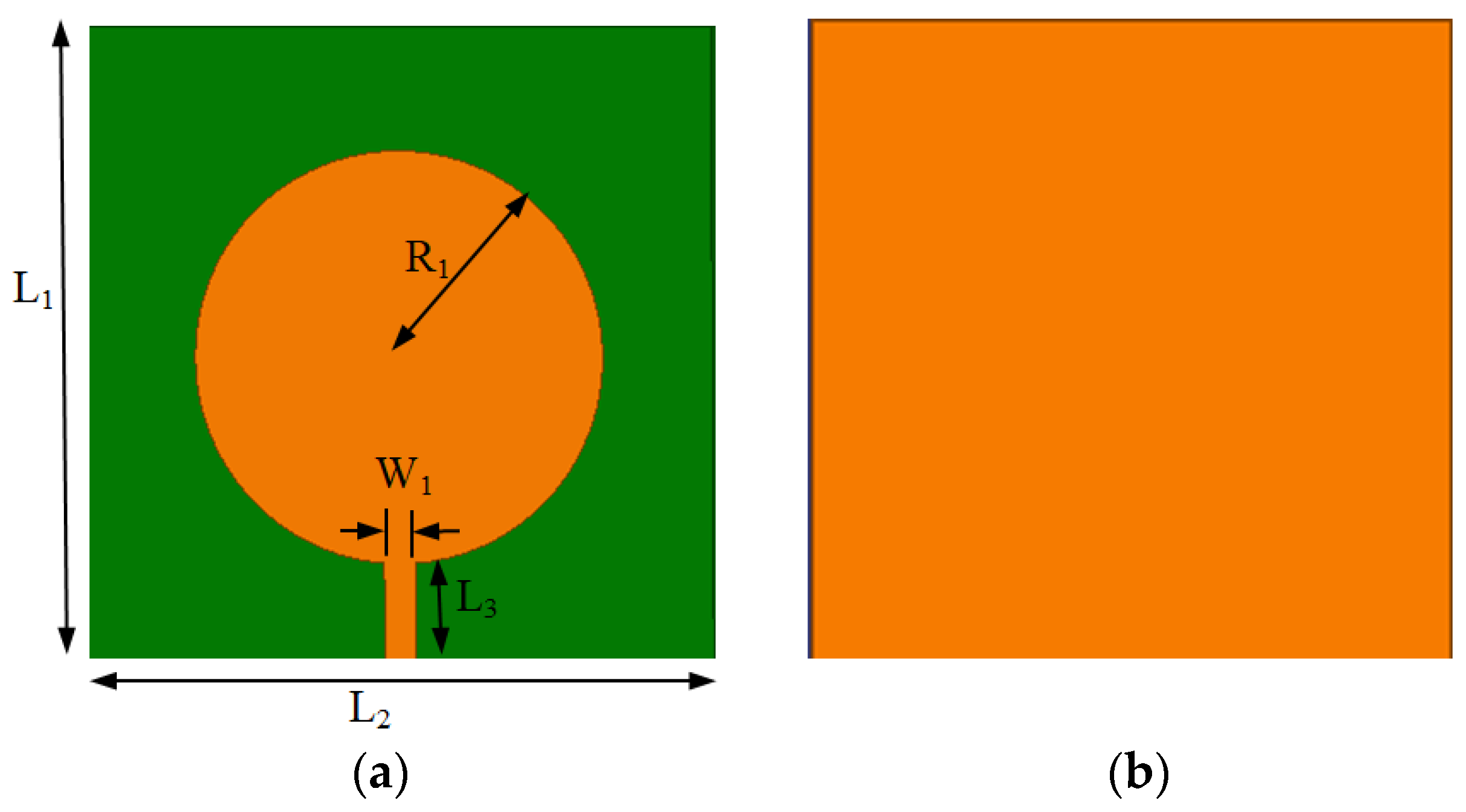
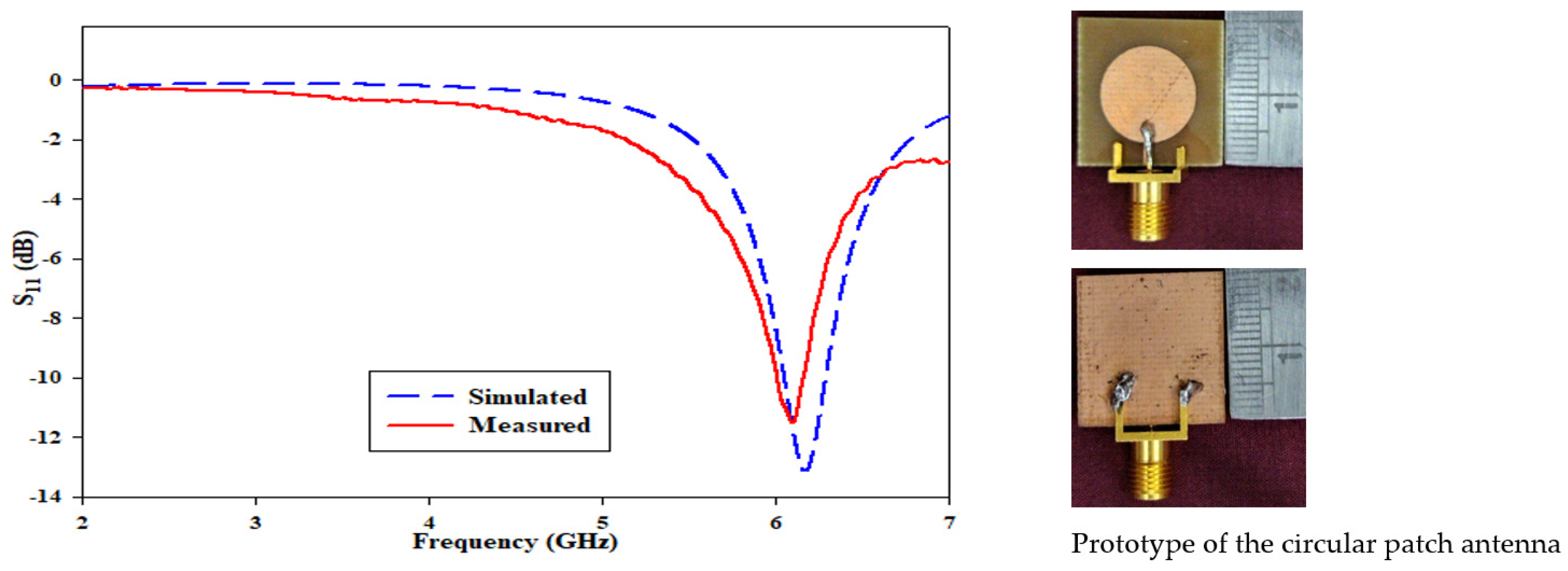
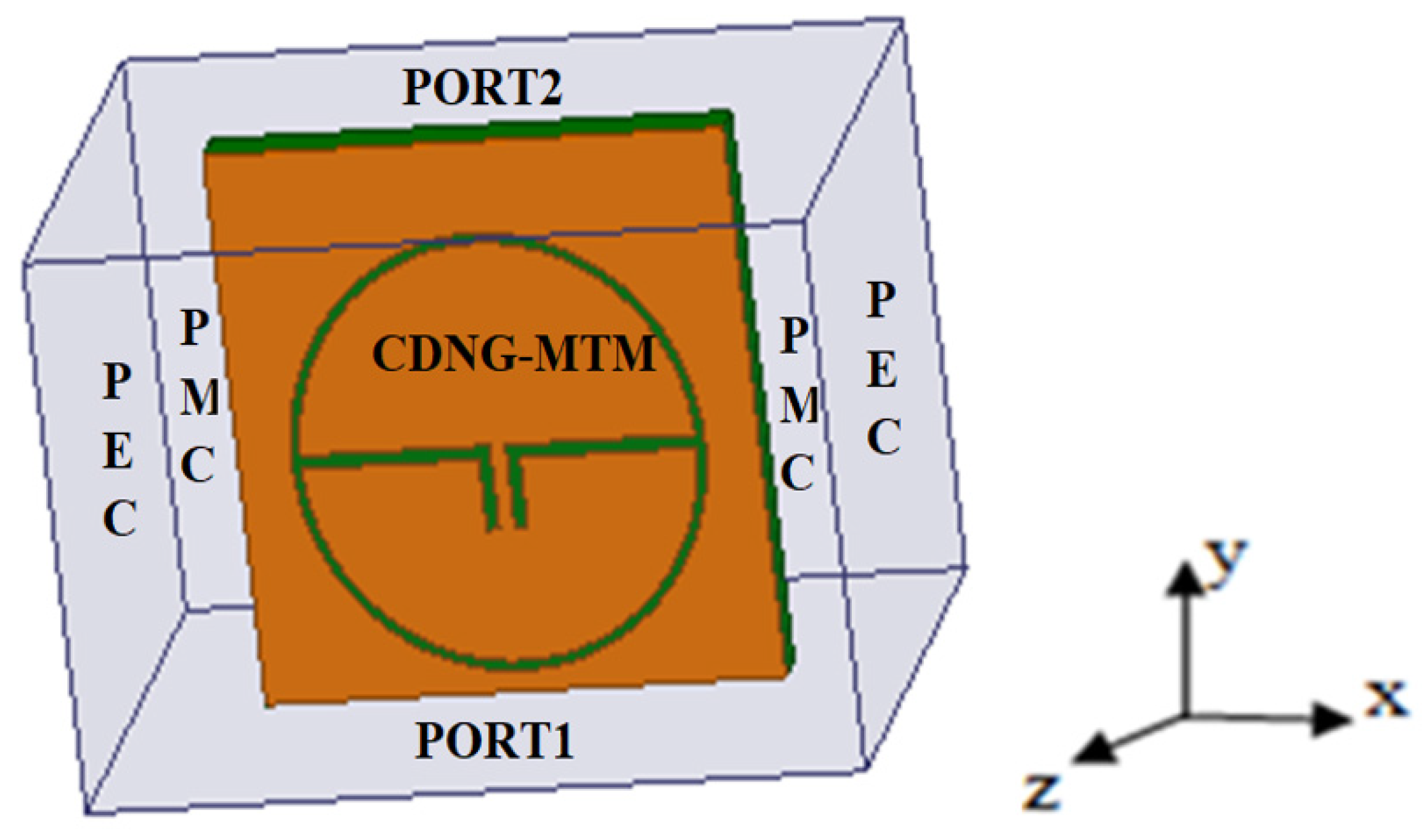


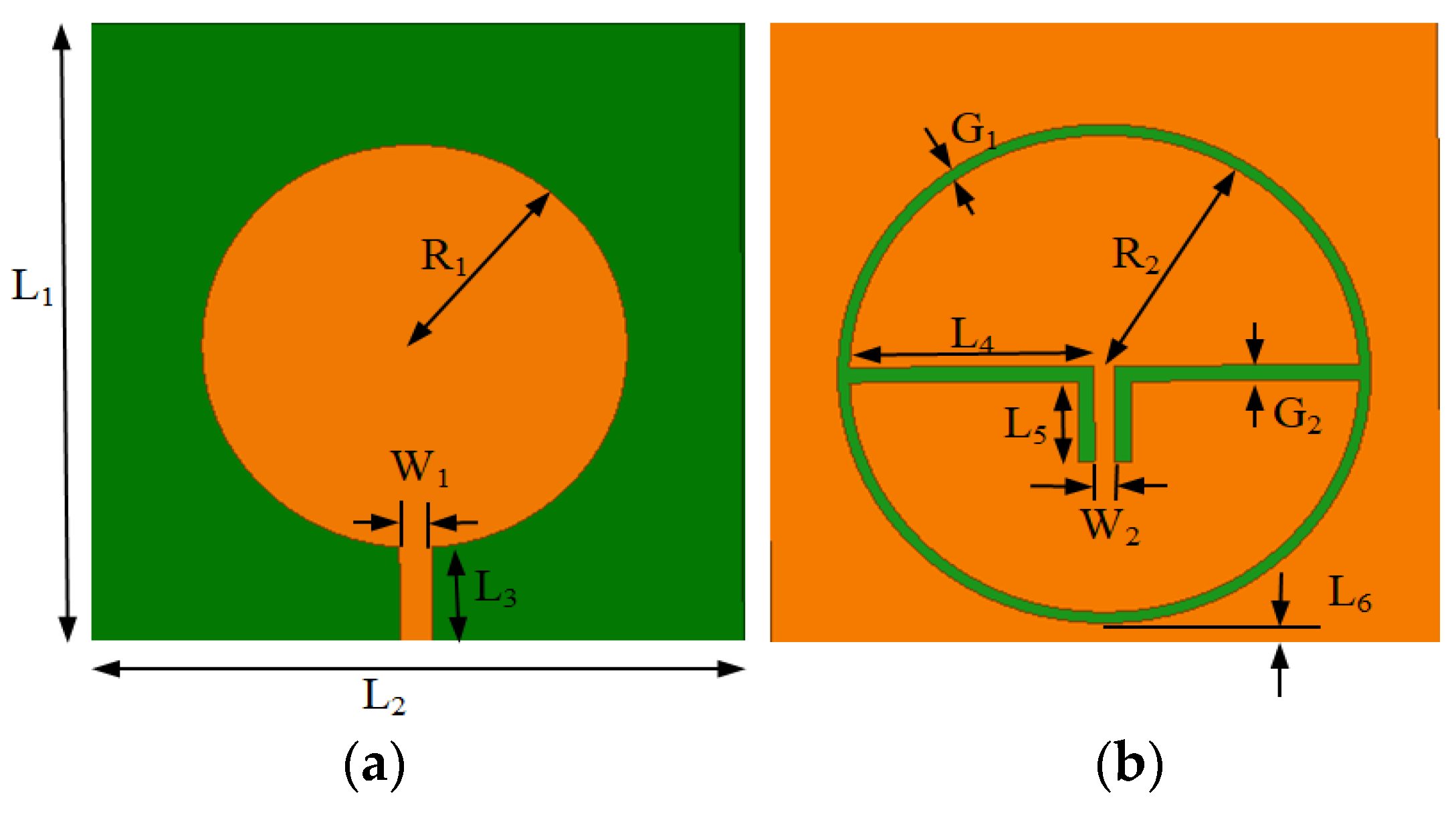


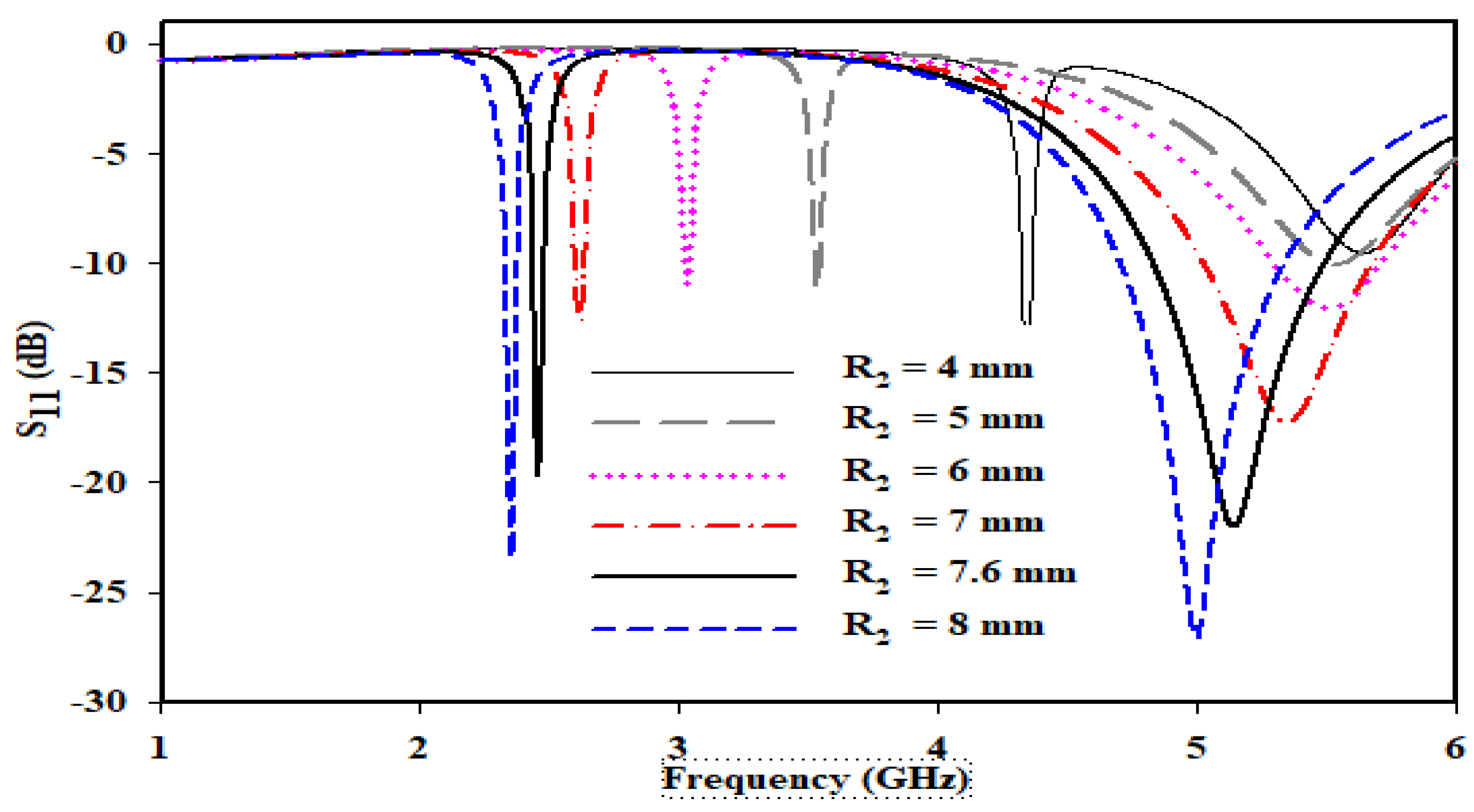
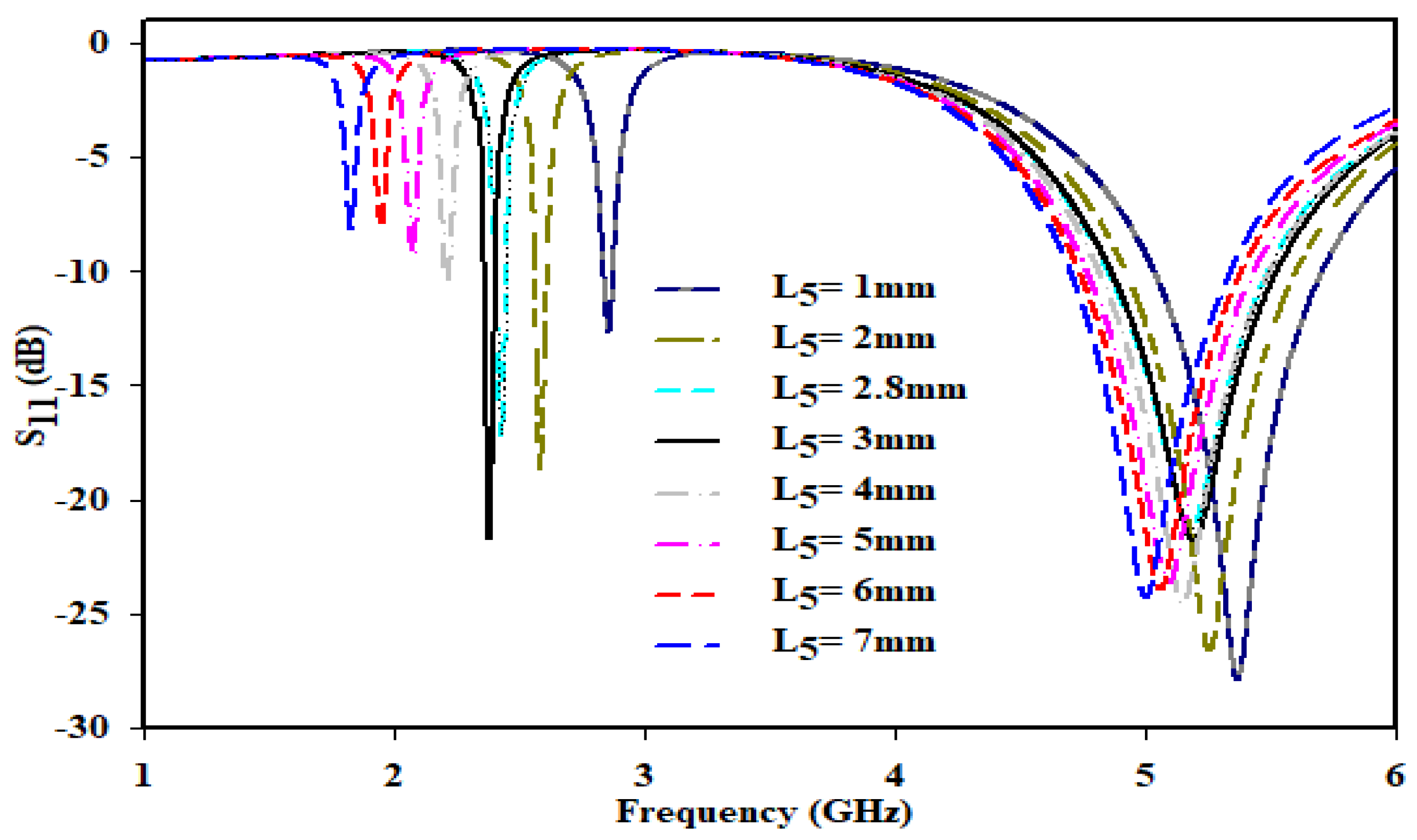
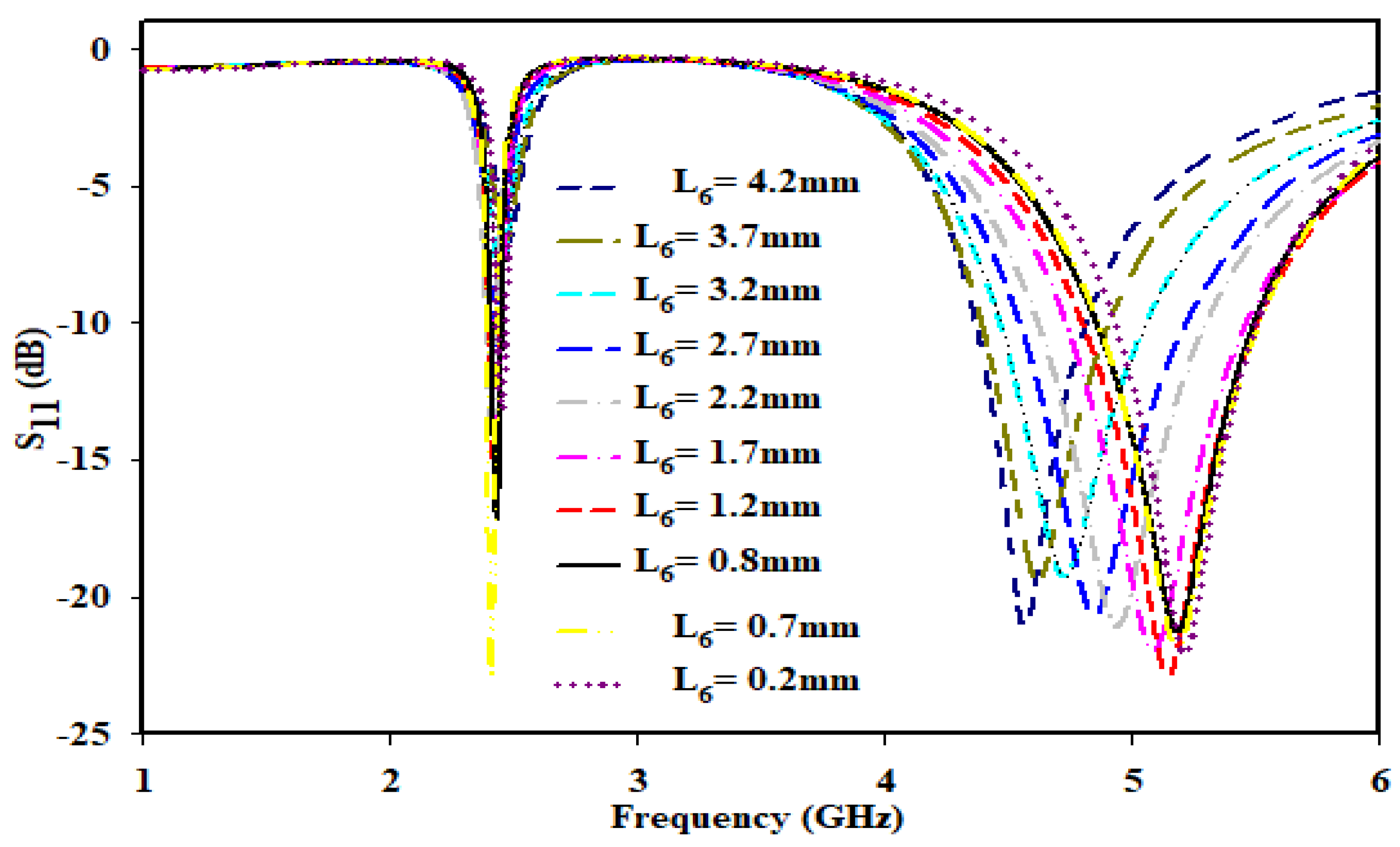


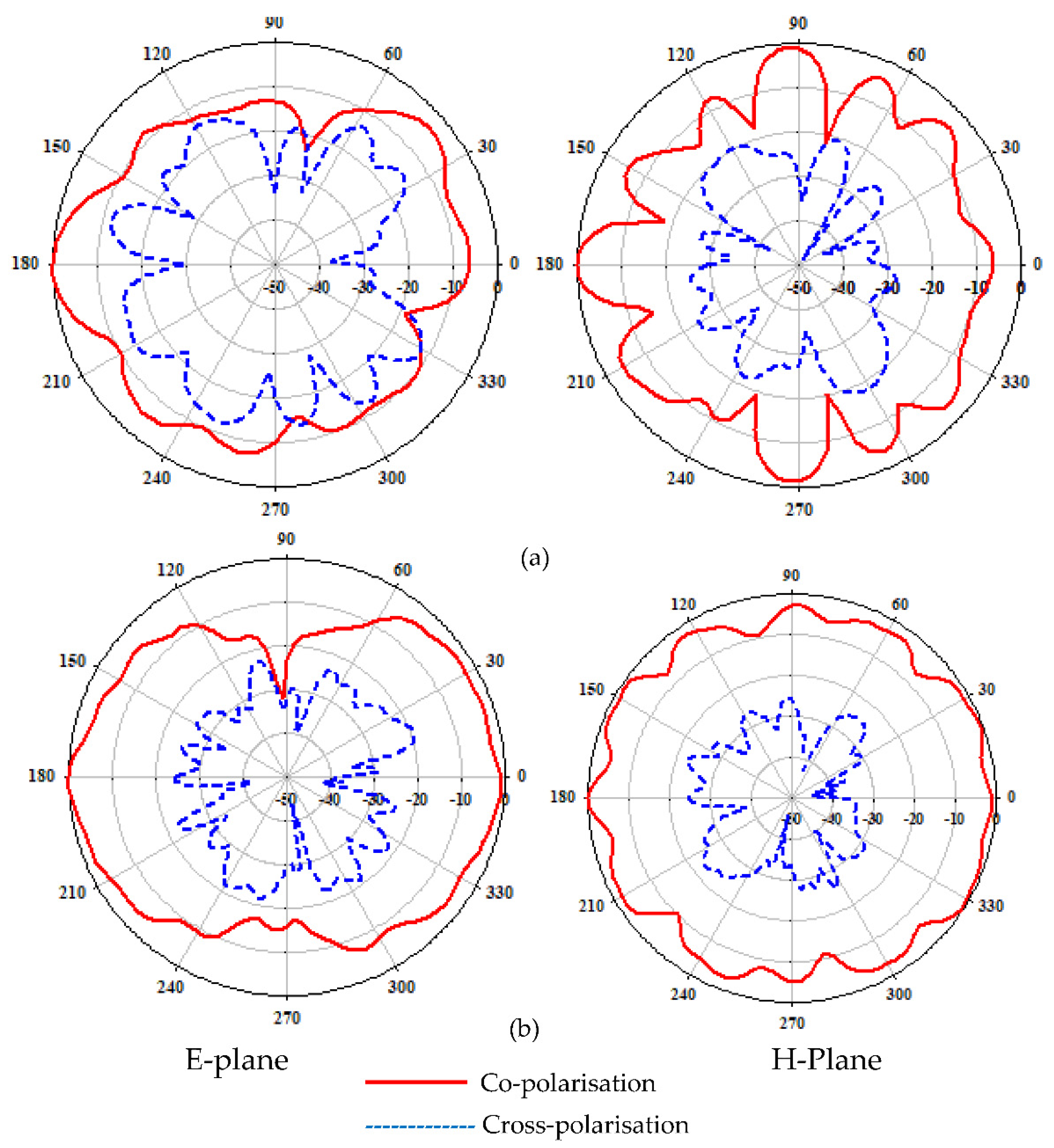
| Parameters | Size (mm) | Parameters | Size (mm) |
|---|---|---|---|
| L1 | 20 | W1 | 1 |
| L2 | 20 | W2 | 0.6 |
| L3 | 3.1 | G1 | 0.35 |
| L4 | 7.3 | G2 | 0.5 |
| L5 | 2.8 | R1 | 6.5 |
| L6 | 0.8 | R2 | 7.6 |
| Antenna | No. of Bands | Frequency (GHz) | Size (λ0) | ka Value | Imp. BW(%) | Gain (dBi) |
|---|---|---|---|---|---|---|
| Patch | 1 | 6.2 | 0.417 × 0.417 | 1.8 | 3.5% | 6 |
| Patch with CDNG | 2 | 2.4 5.2 | 0.164 × 0.164 | 0.72 1.54 | 1.63% 13.15% | 3.8 2.9 |
| Reference/Year | Overall Size |(λ2 & mm2) | Permittivity and Thickness | ka | % Miniaturisation | Resonant Frequency (GHz) | Gain (dBi) | No. of Bands | %BW |
|---|---|---|---|---|---|---|---|---|
| [5]/ 2018 | - 20 × 21 | 4.4 1.6 | 0.75 | - | 0.926 1.57 2.47 | 0.32 1.2 1.5 | 3 | - |
| [6]/ 2021 | - 60 × 70 | 3 1.524 | 0.79 | 44.94 | 1.36 | 1.77 | 1 | 1.13 |
| [8]/ 2017 | 0.197 × 0.246 4 × 5 | 2.2 2.6 | 0.98 | - | 14.76 | 7.16 | 1 | 7.96 |
| [20]/ 2017 | - 40.7 × 61 | 2.2 1.27 | - | 24 | 2 | 6.3 | 1 | - |
| [22]/ 2019 | - 40 × 20 | 4.4 1.6 | - | 81.3 | 2.4 5 | 1.89 3.47 | 2 | - |
| [24]/ 2016 | 0.177 × 0.243 4 × 5.5 | 2.2 2.36 | 0.943 | - | 13.25 | 7.09 | 1 | 7.96 |
| [25]/ 2020 | - 100 × 100 | 4.4 1.6 | - | 50 | 2.4 2.9 4.38 | 3.28 −4.5–3.1 | 3 | - |
| [26]/ 2010 | 0.161 × 0.192 - | 2.2 3.175 | 0.775 | - | 9.51 | 3.2 | 1 | 5.37 |
| Proposed | 0.164 × 0.164 20 × 20 | 4.4 1.6 | 0.72 | 60.7 | 2.4 5.2 | 3.8 2.9 | 2 | 1.63 13.15 |
Publisher’s Note: MDPI stays neutral with regard to jurisdictional claims in published maps and institutional affiliations. |
© 2022 by the authors. Licensee MDPI, Basel, Switzerland. This article is an open access article distributed under the terms and conditions of the Creative Commons Attribution (CC BY) license (https://creativecommons.org/licenses/by/4.0/).
Share and Cite
Thankachan, S.; Paul, B. Dual Band Electrically Small Complementary Double Negative Structure Loaded Metamaterial Inspired Circular Microstrip Patch Antenna for WLAN Applications. Appl. Sci. 2022, 12, 3035. https://doi.org/10.3390/app12063035
Thankachan S, Paul B. Dual Band Electrically Small Complementary Double Negative Structure Loaded Metamaterial Inspired Circular Microstrip Patch Antenna for WLAN Applications. Applied Sciences. 2022; 12(6):3035. https://doi.org/10.3390/app12063035
Chicago/Turabian StyleThankachan, Shiney, and Binu Paul. 2022. "Dual Band Electrically Small Complementary Double Negative Structure Loaded Metamaterial Inspired Circular Microstrip Patch Antenna for WLAN Applications" Applied Sciences 12, no. 6: 3035. https://doi.org/10.3390/app12063035





